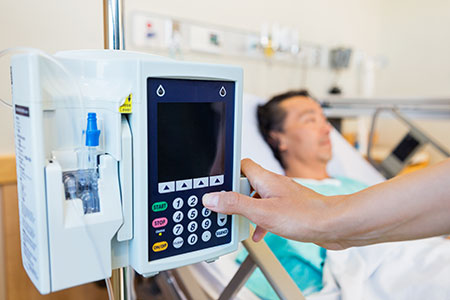This leaflet is for anyone who may benefit from a Patient Controlled Analgesic (PCA) infusion. Here you will find a description of PCA infusion and how it works, together with any side effects that may occur.
Patient Controlled Analgesia (PCA) is a method of pain relief that can be provided after surgery. Your anaesthetist will help you to decide if PCA is the best method for you.
WHAT IS PATIENT CONTROLLED ANALGESIA?
PCA is a type of pain relief, which allows you to manage your own pain relief. You do not have to wait for a nurse to prepare the injections. A special pump containing pain relieving medication allows you to control the amount of pain relief you require.
HOW DOES A PCA MACHINE WORK?
You are connected to a machine which contains a supply of pain-relieving medicine which is connected by a tube to the vein into your arm.
You are given a hand-held button to press, for the machine to give you a dose of the pain relief. The PCA will be programmed by the doctor or nurse to control the dose of pain relief you receive when you press the button.


HOW DO I KNOW IF PCA IS SUITABLE FOR ME?
PCA is suitable for a wide range of patients following surgery. Your doctor or nurse will help you decide if PCA is appropriate for you. You will need to be able to press a hand-held button attached to the PCA pump.
WHEN WILL I START USING THE PCA?
You are able to press the button as soon as you are wake from your operation, however if you find difficulty in pressing the button you must inform your nurse.
HOW OFTEN SHOULD I PRESS THE BUTTON?
If you feel your pain is uncomfortable simply press the button on the hand set. You cannot give yourself too much as there is a timer built into the machine to stop you having too much. It is important to remember that the chance of you becoming addicted to the pain relief is very unlikely.
HOW LONG SHOULD I USE IT FOR?
For as long as necessary. Generally, after 48 hours most patients find that their pain is controlled well on tablets, however it is important to note that tablets must be taken at regular intervals and not only when you have pain.
ADVANTAGES AND DISADVANTAGES
- With the PCA you are in control of your own pain relief, you do not have to wait for the nurses to bring your pain relief.
- You will be able to move about the bed more easily and get out of bed sooner than with most other kinds of pain relief.
- Patients with good pain relief progress more quickly and go home earlier.
- PCA is very safe as long as only you press the button. Only you know how much pain you feel and how much pain relief you need to relieve it.
- PCA is safe and effective, but this strong pain relief can cause side effects in some people. You may feel slightly drowsy at times, this is quite normal. Very occasionally some patients may experience allergic reaction, nausea or vomiting, constipation, low blood pressure or even trouble breathing (respiratory depression). Please tell your nurse if you feel any of these so that you can be given an appropriate care.
Your healthcare team will strictly monitor for respiratory depression if you are an older adult, have asthma or other lung problems, are obese, have sleep apnoea, are not used to opioids or need high doses of opioids for pain relief.
WILL I BE GIVEN OTHER PAIN RELIEF?
You may be given paracetamol and sometimes an anti-inflammatory drug as well as the PCA. This combination of drugs will give you the very best possible pain relief.
PAIN ASSESSMENT

You will be asked by your nurse to describe your pain to ensure your pain relief is working well.
You will be asked to describe your pain on a visual scale or on a numeric scale between 0 and 10.

If you have any questions the anaesthetists or the nurses on the ward will be happy to talk with you.

 Vi
Vi 












